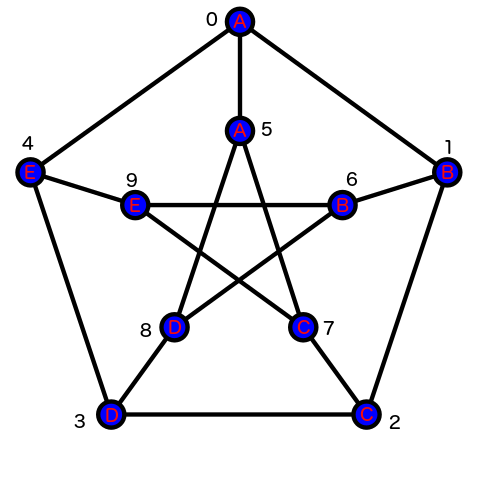---category_name: easyproblem_code: PETERSENproblem_name: 'Petersen Graph'languages_supported:- ADA- ASM- BASH- BF- C- 'C99 strict'- CAML- CLOJ- CLPS- 'CPP 4.3.2'- 'CPP 4.9.2'- CPP14- CS2- D- ERL- FORT- FS- GO- HASK- ICK- ICON- JAVA- JS- 'LISP clisp'- 'LISP sbcl'- LUA- NEM- NICE- NODEJS- 'PAS fpc'- 'PAS gpc'- PERL- PERL6- PHP- PIKE- PRLG- PYTH- 'PYTH 3.4'- RUBY- SCALA- 'SCM guile'- 'SCM qobi'- ST- TCL- TEXT- WSPCmax_timelimit: '1'source_sizelimit: '50000'problem_author: kostya_byproblem_tester: nulldate_added: 25-10-2014tags:- bfs- cook52- graphs- kostya_by- simple- traversaleditorial_url: 'http://discuss.codechef.com/problems/PETERSEN'time:view_start_date: 1416767862submit_start_date: 1416767862visible_start_date: 1416767794end_date: 1735669800current: 1493558173layout: problem---All submissions for this problem are available.### Read problems statements in [Mandarin Chinese](http://www.codechef.com/download/translated/COOK52/mandarin/PETERSEN.pdf) and [Russian](http://www.codechef.com/download/translated/COOK52/russian/PETERSEN.pdf) as well.The following graph **G** is called a [Petersen graph](http://en.wikipedia.org/wiki/Petersen_graph) and its vertices have been numbered from 0 to **9**. Some letters have also been assigned to vertices of **G**, as can be seen from the following picture:Let's consider a walk **W** in graph **G**, which consists of **L** vertices **W1**, **W2**, ..., **WL**, such that **Wi** is connected with **Wi + 1** for 1 ≤ **i** < **L**. A string **S** of **L** letters **'A'-'E'** is realized by walk **W** if the sequence of letters written along **W** is equal to **S**. Vertices can be visited multiple times while walking along **W**.For example, **S** = **'ABBECCD'** is realized by **W** = (0, 1, 6, 9, 7, 2, 3).Your task is to determine whether there is a walk **W** which realizes a given string **S** in graph **G**, and if so, find the lexicographically least such walk.### InputThe first line of the input contains one integer **T** denoting the number of testcases to process.The only line of each testcase contains one string **S**. It is guaranteed that **S** only consists of symbols **'A'-'E'**.### OutputThe output should contain exactly **T** lines, one line per each testcase in the order of their appearance. For each testcase, if there is no walk **W** which realizes **S**, then output **-1**. Otherwise, you should output the least lexicographical walk **W** which realizes **S**. Since all of the vertices are numbered from 0 to **9**, then it can be encoded as a string consisting of symbols **'0'-'9'** (see the "Examples" section for more details).### Constraints1 ≤ **T** ≤ 8;1 ≤ **|S|** ≤ 100000(105).### Examples<pre><b>Input:</b>2AABAABE<b>Output:</b>501-1</pre>